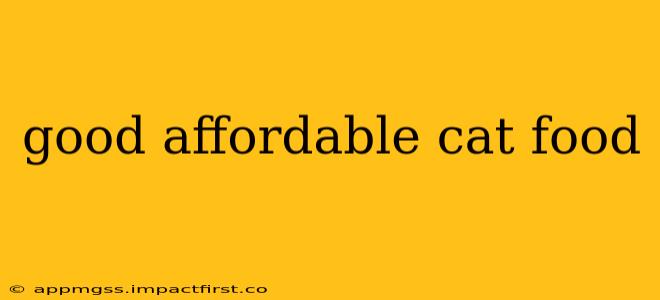Finding good, affordable cat food can feel like a never-ending quest. You want to give your feline friend the best nutrition possible, but budget constraints can make that seem challenging. This comprehensive guide will help you navigate the world of cat food, uncovering affordable options that won't compromise your cat's health and happiness. We'll explore different types of cat food, key ingredients to look for, and factors to consider when making your selection.
What Makes Cat Food "Good"?
Before diving into affordability, let's define what constitutes "good" cat food. A good quality cat food should meet the Association of American Feed Control Officials (AAFCO) nutritional standards. These standards ensure the food provides the necessary nutrients for your cat's life stage (kitten, adult, senior). Look for foods that list named meat sources (like "chicken" or "turkey") as the primary ingredients, rather than vague terms like "meat by-products." Avoid foods with excessive fillers, artificial colors, and flavors. High-quality protein is crucial for a cat's muscle mass, coat health, and overall well-being.
What are the Best Affordable Cat Food Brands?
There isn't a single "best" brand, as individual cats have different preferences and dietary needs. However, several brands consistently offer good quality at reasonable prices. These often include:
- Friskies: A widely available and budget-friendly option, Friskies offers a range of dry and wet foods. Be sure to check the ingredient list to ensure a good balance of protein and avoid excessive fillers.
- Purina Fancy Feast: While not always the absolute cheapest, Fancy Feast often offers sales and promotions, making it a worthwhile option. Their wet food is particularly popular with many cats.
- Blue Buffalo Basics: While positioned slightly higher in price than the above, Blue Buffalo Basics still offers a good value for its quality, focusing on simple ingredients.
- Wellness Complete Health: This brand offers a slightly pricier, but still budget-conscious option with better quality ingredients and higher protein levels.
It's important to note: Prices can vary greatly depending on location and retailer. Comparing prices across stores and utilizing coupons or sales can significantly impact your overall cost.
Is Dry or Wet Food Better (and More Affordable)?
This is a common question with no definitive answer. Dry food is generally cheaper per calorie, making it a more affordable option for long-term feeding. However, wet food has a higher moisture content, which can be beneficial for cats prone to urinary tract issues. Many cat owners opt for a combination of both dry and wet food to provide variety and meet their cat's hydration needs.
How much should I feed my cat?
Always follow the feeding guidelines on the food packaging. These guidelines are based on your cat's weight and activity level. Overfeeding can lead to obesity, which can cause various health problems.
What About Grain-Free Cat Food? Is it Worth the Extra Cost?
Grain-free cat food has become increasingly popular, but it's not necessarily superior to food containing grains. The decision to choose grain-free should be based on your cat's individual needs and any potential allergies. Grain-free options tend to be more expensive. Consult your veterinarian before switching to a grain-free diet.
What are the Key Ingredients to Look for in Affordable Cat Food?
Prioritize named meat sources (chicken, turkey, fish) as the first few ingredients. Look for healthy fats like chicken fat or fish oil, which are essential for a shiny coat and healthy skin. Avoid artificial colors, flavors, and preservatives whenever possible.
How Can I Save Money on Cat Food?
- Buy in bulk: Larger bags or cases of food often offer better value per pound.
- Utilize coupons and sales: Check grocery store flyers and websites for deals.
- Consider store brands: Many grocery stores offer their own brands of cat food, which are often more affordable than name brands.
- Compare prices: Don't automatically assume the cheapest option is the best. Compare the price per calorie or per ounce to make informed decisions.
- Make your own cat food: While more time-consuming, making your own food can save money in the long run, but ensure you consult with your veterinarian on creating a balanced diet for your cat.
By considering these factors and exploring the various affordable options available, you can provide your cat with nutritious food without breaking the bank. Remember, consulting with your veterinarian is always recommended when making significant changes to your cat's diet.
